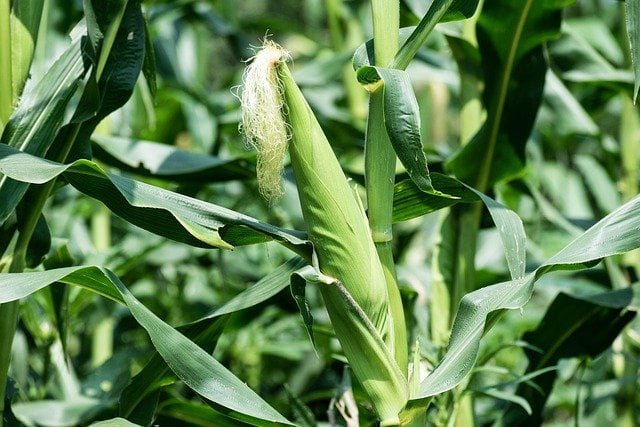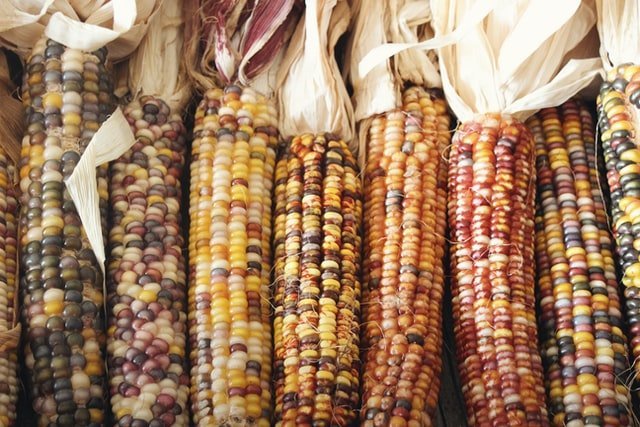In this article, you will learn about Maize Cultivation. Maize (ज़िया मेस L) is one of the most versatile emerging crops having wider adaptability under varied agro-climatic conditions.
Globally, maize is known for highest genetic yield potential among the cereals. It is cultivated in about 160 countries having wider diversity of soil, climate, biodiversity and management practices that contributes 36 % in the global grain production.
The USA has the highest productivity (> 9.6 t ha-1) which is double than the global average (4.92 t ha-1). But, in भारत the average productivity is 2.43 t ha-1.
Table of Contents
एलोवेरा की उत्पत्ति
- The primary centre of origin of maize is considered by most authorities to be the Central America और मेक्सिको, where many diverse types of maize are found.
- The discovery of fossil maize pollen with other archaeological evidence in Mexico indicates Mexico to be the native of maize.
- It is believed that Portuguese introduced it to India from Europe during early sixteenth century.
Geographical Distribution of Maize Cultivation
Maize is cultivated throughout the world over a wide range of environment.
- From 58°N latitude to 40°S latitude, the crop spreads and cultivated over 185 million ha of area and around 600 million tonnes of maize is produced.
- Maize Crop is at the third position next to rice and wheat in area and production.
- USA, China, Brazil, Mexico, India, Romania, Philippines, Indonesia are some of important countries cultivate maize crop.
- In India, Rajasthan, UP, MP, Bihar, Karnataka, Gujarat, AP, J&K, HP and Maharashtra are important states produce maize.
आपको इन्हें पढ़ना भी अच्छा लगेगा:
और पढ़ें: RICE CULTIVATION IN DETAIL
और पढ़ें: 3G CUTTING: CAN INCREASE YOUR CROP PRODUCTIVITY!
Economic Importance of Maize Cultivation
It is staple human food, feed for livestock, for fermentation and lots of industrial uses.
- It is having abundant starch (65%).
- There are two types of milling. Wet milling products are industrial starch like sweeteners. It also produces various modified maize starch for paper lamination, textile wrap, sizing and laundry finishing.
- Animal feed, brewing, breakfast cereals, other food are dry milled products.
- Dry milling is the predominant process for flour and animal feed, fermentation and distilling industries and composite flours in India.
- It is an alternate crop to rice and wheat in the new millennium. About 35% production of the overall production is consumed by human, and the rest 25% poultry and cattle feed, 15% food processing.
क्षेत्र और उत्पादन
In world:
Maize growing country: China > USA> Brazil> India Maximum Area: China
Maximum Production: USA
Maximum Productivity: St Vincent and Grenadines Area: 185 Million hectare
Production: 1020 Million Tonnes
Productivity: 5500 Kg/ha
In India:
Area: 10 Million hectare
Production: 18.73 Million tonnes
Productivity: 2500 kg/ha
Classification of Maize based on Crop Duration
- Full Season Maturity: 100-110 days, they may be rainfed or irrigated
- Medium Maturity: 85-90 days, suited well to regions with assured rainfall
- Early maturity: 80-85 days, suitable for sole and intercropping
- Very early maturity: 75-80 days, suited for summer season or intercropping.
- Extra early maturity: suited for rainfed condition at high altitude with low temperature
मक्का की खेती गाइड

मिट्टी की आवश्यकता
- Deep, fertile, rich in organic matter and well drained soils are the foremost preferred ones for the crop; however, maize are often grown on a spread of soil types.
- Medium textured with good water holding capacity soil is preferred.
- The crop is extremely sensitive to water logging and since it’s mainly grown during season , care should be taken to assure that water doesn’t stagnate on the soil surface for quite 4-5 hours.
Loamy or silty loam soil or silty clay loam soil having fairly permeable sub soil is right soil types.
Thus, the perfect soil is neither clayey or sandy and features a pH between 6.5 and 7.5 along side an exchangeable capacity of around 20 milli-equivalent/100g, base saturation of 70-90%, bulk density of about 1.3 g/cc and water-holding capacity of about 16cm/m depth.
जलवायु
Germination:
For germination and seedling growth the soil temperature should be 26 to 30 degree C. Minimum temperature for germination is 10 degree C and the ideal temp is 21 degree C.
वनस्पति चरण
The range of temperature for maize growth is from 9 to 46 degree C with optimum around 34 degree C When mean daily temp below 20 degree C crop duration will be extended by 10 to 20 days for each 0.5 degree C decrease.
Reproductive Phase
Optimum temperature at tasselling is 21 to 30 degree C.
High temperature increase the rate of grain filling but reduces the duration of grain filling thereby reducing the yield, whereas low temperature cause an inverse response because of greater partitioning of photosynthesis dry matter to grain.
मौसम
- Maize can be grown in all seasons viz; Kharif (monsoon), post monsoon, Rabi (winter) and spring, in all seasons maize can be grown.
- During Rabi and spring seasons to achieve higher yield at farmer’s field assured irrigation facilities are required. The optimum time of sowing is last week of October for inter cropping and up to 15th of November for sole crop.
- During Kharif season it is desirable to complete the sowing operation 12-15 days before the onset of monsoon. However, in rainfed areas, the sowing time should be coincided with onset of monsoon. The optimum time of sowing is last week of June to first fortnight July.
- For spring season the optimum time of sowing is First week of February.
खेत की तैयारी
Tillage and crop establishment is that the key for achieving the optimum plant stand that’s the most driver of the crop yield.
- Though the crop establishment is a series of events (seeding, germination, emergence and final establishment) that depends on interactions of seed, seedling depth, soil moisture, method of sowing, machinery etc but, the tactic of planting plays an important role for better establishment of crop under a group of growing situation.
- Maize is mainly sown directly through seed by using different methods of tillage & establishment but during winters where fields are not remain vacant in time (till November), transplanting can be done successfully by raising the nursery.
- The sowing method mainly depends on several factors that are the complex interaction over time of seeding, soil, climate, biotic, machinery and management season, cropping system, etc.
- Recently, resource conservation technologies (RCTs) that are cost effective and environment friendly include several practices viz. zero tillage, minimum tillage, surface seeding etc. had came in practice in various maize based cropping system.
- Therefore it is very important that different situations require different sowing methods for achieving higher yield as described below:
(i) Raised bed (ridge) planting:
- Generally the raised bed planting is considered as best planting method for maize during monsoon and winter seasons both under excess moisture as well as limited water availability/rainfed conditions.
- Sowing/planting should be done on the southern side of the east-west ridges/beds, which helps in good germination.
- Planting should be done at proper spacing. Preferably, the raised bed planter that have inclined plate, cupping or roller type seed metering systems could be used for planting. This facilitates in placement of seed and fertilizers at proper place in one operation. This technique helps in getting good crop stand, higher productivity and resource use efficiency.
- 20-30 % irrigation water can be saved with higher productivity by using raised bed planting technology.
- Moreover, under temporary excess soil moisture/water logging due to heavy rains, the furrows will act as drainage channels and crop can be saved from excess soil moisture stress.
- For realizing the full potential of the bed planting technology, permanent beds are advisable wherein sowing can be done in a single pass without any preparatory tillage.
- Permanent beds are more beneficial under excess soil moisture situations as the infiltration rate is much higher and crop can be saved from the temporary water logging injury.
(ii) Zero-till planting:
- Maize can be successfully grown without any primary tillage under no-till situation with less cost of cultivation, higher farm profitability and better resource use efficiency.
- Under such condition one should ensure good soil moisture at sowing and seed and fertilizers should be placed in band using zero till seed-cum-fertilizer planter with furrow opener as per the soil texture and field conditions.
- Under rice-maize and maize-wheat systems in peninsular and eastern India the technology is in place with large number of farmers.
- But, use of appropriate planter that have suitable furrow opener and seed metering system can prove successful and is the key of success of the no-till technology.
(iii) Conventional till flat planting:
Under heavy weed infestation where chemical/herbicidal weed management is uneconomical in no-till and also for rainfed areas where survival of crop depends on conserved soil moisture, in such situations flat planting can be done using seed-cum-fertilizer planters.
(iv) Furrow planting:
To prevent evaporative losses of water during spring season from the soil under flat as well as raised bed planting is higher and hence crop suffers due to moisture stress. Under such situation/condition, it’s always advisable to grow maize in furrows for correct growth, seed setting and better productivity.
बीज दर
Select good quality seeds and adopt the seed rate of 20 kg/ha to 25 kg /ha depending on hybrids/varieties.
Transplanting
Under intensive cropping systems where it is not possible to vacate the field on time for planting of winter maize, the chances of delayed planting exists and due to delay planting crop establishment is a problem due to low temperature so under such conditions transplanting is an alternative and well established technique for winter maize.
- Because of this reason, for the situation where fields are vacated during December-January, different authorized body advises to grow nursery and transplant the seedlings in furrows and apply irrigation for optimum crop establishment.
- Using this technique eventually helps in maintenance of temporal isolation in corn seed production areas. It is for production of pure and good quality seed as well as quality protein maize grain.
- For planting of one hectare, 700 m2 nursery area is required and the nursery should be raised during second fortnight of November. The age of seedlings for transplanting should be 30-40 days old (depending on the growth) and transplant in the month of December-January in furrows to obtain higher productivity.
पौधों के बीच की दूरी
Adopt a spacing of 60X25 cm. This means that distance should be 25 cm between plants in the rows that are 60 cm apart. For hybrids 6–7 plants / sq. m. 8 – 9 plants / sq. m. is considered good for baby corns.
Nutrient Management
- Maize generally and hybrids especially are aware of nutrients applied either through organic or inorganic sources.
- The rate of nutrient application depends mainly on soil nutrient status/balance and cropping system.
- For obtaining desirable yields, the doses of applied nutrients should be matched with the soil supplying capacity and plant demand (Site-specific nutrient management approach) by keeping in sight of the preceding crop (cropping system).
- Response of maize to applied organic manures is notable and hence integrated nutrient management (INM) is extremely important nutrient management strategy in maize based production systems.
- Therefore, for higher economic yield of maize, application of 10 t FYM ha-1, 10-15 days before sowing supplemented with 150-180 kg N, 70-80 kg P2O5, 70-80 kg K2O and 25 kg ZnSO4 ha-1 is suggested.
- Complete doses of P, K and Zn should be applied as basal doze. It can be done preferably by drilling of fertilizers in bands along the seed using seed-cum fertilizer drills.
- Application of nitrogen should be in 5-splits as detailed below for higher productivity and use efficiency.
- N application at grain filling leads to better grain filling. Therefore, nitrogen should be applied in five splits as per below mentioned for higher N use efficiency.
Crop Stage Nitrogen rate (%)
1. Basal (at sowing) 20% 2. V4 (four leaf stage) 25% 3. V8 (eight leaf stage) 30% 4. VT (tasselling stage) 20% 5. GF (grain filling stage) 5%
- Nutrient deficiencies in crops reduce yields, quality and profits to the farmer.
- Yield can often be reduced 10-30% by deficiencies of major nutrients before any clear symptoms of deficiency are observed within the field.
Nitrogen deficiency: Leaves become yellow, older leaves show drying at the ideas which progress along mid veins, stalks become slender.
Phosphorus deficiency: Leaves colour changes to purplish green during early growth. Growth spindly, slow maturity, irregular ear formation.
Potassium deficiency: Leaves show yellow or yellow green streaks, become corrugated. Tips and marginal scorch. Tips end in ears are poorly filled. Stalks have short internode. Plants become weak and may subside.
Magnesium deficiency: Older leaves are the primary to become chlorotic at margins and between veins. Streaked appearance of leaves. Necrotic or chlorotic spots seen in leaves.
Zinc deficiency: Older leaves have yellow streaks or chlorotic striping between veins. In several cases, unfolding of young leaves, which can be white or yellow.
Iron deficiency: Interveinal chlorosis. the whole crop may exhibit bleached.
Irrigation Management
The irrigation water management depends on season as about 80 you look after maize is cultivated during monsoon season particularly under rainfed conditions.
However, in areas with assured irrigation facilities are available, depending upon the rains and moisture holding capacity of the soil, irrigation should be applied as and when required by the crop.
First irrigation should be applied very carefully wherein water shouldn’t overflow on the ridges/beds.
In general, the irrigation should be applied in furrows up to 2/3rd height of the ridges/beds. Ensure optimum moisture availability during the most critical phase (45 to 65 days after sowing); otherwise yield will be reduced by a considerable extent.
Regulate irrigation consistent with the subsequent growth phase of the crop.
Critical stages for irrigating maize crop field are, 6th leaf, late knee high, tasselling, 50% silking and dough stages. Of which, tasselling and silking are found to be the most Critical stages and water stress during these stages reduces the maize yields considerably.
In raised bed planting system and limited irrigation water availability conditions, the irrigation water can also be applied in alternate furrow to save more irrigation water.
In rainfed areas, tied-ridges are helpful in conserving the rainwater for its availability in the root zone for longer period.
For winter maize, it’s advisable to stay soil wet (frequent & mild irrigation) during 15 December to fifteen February to guard the crop from frost injury.
खरपतवार प्रबंधन
Weeds are the intense problem in maize, particularly during kharif /monsoon season they competes with maize for nutrient and causes yield loss up to 35 %.
Therefore, timely weed management is required for achieving higher yield. Atrazine being a selective and broad-spectrum herbicide in maize checks the emergence of wide spectrum of weeds.
Pre-emergence application of Atrazine (Atratraf 50 wp, Gesaprim 500 fw) @ of 1.0-1.5 kg ha-1 in 600 litre water, Alachlor (Lasso) @ 2-2.5 kg ha-1, Metolachlor (Dual) @ 1.5-2.0 kg ha-1, Pendamethalin (Stomp) @ 1-1.5 kg ha-1 are effective way for control of the many annual and broad leaved weeds.
While spraying, following precautions should be taken care by the person during spray, he should move backward in order that the Atrazine or the other herbicide film on the soil surface might not be disturbed.
Preferably three boom flat fan nozzle should be used for correct ground coverage and saving time. One to 2 hoeing are recommended for aeration and uprooting of the remaining weeds, if any.
For areas where zero tillage is practiced, pre-plant application (10-15 days before seeding) of non-selective herbicides viz., Glyphosate @ 1.0 kg ha-1 in 400-600 litre water or Paraquat @ 0.5 kg ha-1 in 600 litre water is suggested to regulate the weeds.
Other herbicides Atrazine, Simazine, Alachlor, Fluchloraline can also be used.
Under heavy weed infestation, post-emergence application of Paraquat also can be done as protected spray using hoods. Combination of two herbicides like Acetachlor + Safenar, Alachlor + Atrazine, metolachlor trifluralin also can be used.

Harvesting of Maize Crop
Stage of harvest:
Observe the subsequent symptoms, taking into consideration the typical duration of the crop. Yellowing and drying of the sheath covering the cob at maturity. The seeds become fairly hard and dry. At this stage the crop is prepared for harvest. Moisture content is nearly 20-24%.
Harvesting:
Tear-off the cob sheath by using the gunny needle and remove the cobs from the plant. For easy transportation farmers can carry out harvest operations at a single stage.
Threshing cobs:
Place the cobs under the sun to dry. Leave then under sun till the grains are dry. Use mechanical threshers to separate the grains from the shank. Clean the seeds by winnowing. Collect and store the dry grains in gunnies.
Stalk for cattle feed:
Maize straw also can be used as an honest cattle feed when it’s green. Harvest the crop and cut the green straw with a chaff cutter and feed the cattle.
Yield of Maize
- In temperate region: maximum 22 t/ha but at commercial level it is 10 t/ha.
- In tropical regions: maximum 12 t/ha due to long rainy season and at very specific environmental conditions but the average yield is 5-8 t/ha with good management.
- Maize yield = kernel number/unit area x kernel wt.
- Kernel weight is almost stable while the variation is largely due to kernel number.
- Kernel number is depend on events before and around flowering e.g. Soil moisture, nitrogen content and sunlight radiation.
- Yield reduces with any kind of biotic or abiotic stress, nutritional stress etc.
- Simultaneous improvement in crop management practices and germplasm can help in getting higher yield.
- Considerable variation in grain yield found in India due to differences in cultivar used, fertilizer doses, rainfall etc.






it is good review for maize cultivation
Thanks!
this was very helpful. thanks a lot.
स्वागत!